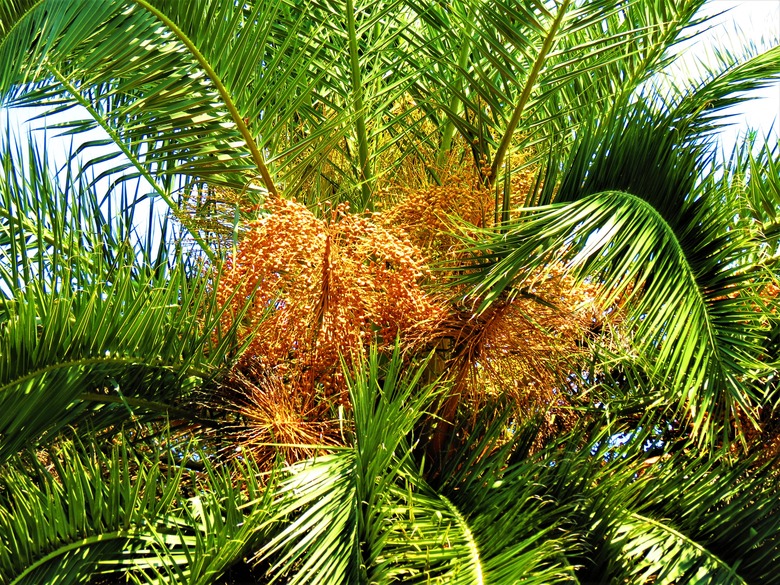Are Queen Palm Tree Nuts Poisonous To Dogs?
We may receive a commission on purchases made from links.
The graceful palm trees that line streets and rise above the landscape in the Southwest and Florida often include the queen palm (Syagrus romanzoffiana). Hardy in U.S. Department of Agriculture plant hardiness zones 9b through 11, these feather palms produce small yellow to orange fruits. While queen palm tree nuts are not poisonous to dogs, horses or humans, the hard seeds present other hazards to pets and children.
Tip
While queen palm tree nuts are not poisonous to dogs, eating them is not advised. Your pets may have gastrointestinal issues if they eat the nuts or any other part of a palm tree.
About the Queen Palm Tree
About the Queen Palm Tree
The queen palm, a native of southern Brazil and northern Argentina, tolerates acidic clay, loam or sandy soils as long as they are well-drained. While the trees tolerate temperatures as low as 20 to 25 degrees Fahrenheit, a plus in the Southwest, they generally grow better in Florida due to the higher humidity. At up to 50 feet tall and 20 to 30 feet wide, queen palms are used as street or specimen trees in landscapes and parks.
The fronds of the queen palm must be trimmed when they die; the tree is not self-cleaning. In addition, the fruit clusters can weigh up to 100 pounds, which is a hazard when they fall from the tree. When pruning the palm tree, put on all safety gear, including gloves and safety goggles, and sterilize your pruning tools by dipping the blades in rubbing alcohol or a household pine cleaner to prevent the spread of fungal diseases. Alternatively, play it safe and call in a professional tree service with a bucket lift to prune the dead fronds and fruit clusters.
Queen Palm Tree Nuts and Dogs
Queen Palm Tree Nuts and Dogs
The hard nut of the queen palm tree and the sticky, sweet flesh that surrounds it are not toxic to dogs, cats or humans. While not toxic, eating the hard seeds is not advised. Like any other vegetative matter, the nuts can cause gastric distress if eaten by your dog. The seeds are not only a choking hazard but they can cause intestinal blockages if swallowed.
When ripe, the 1/2- to 1 1/2-inch-diameter fruits are sweet with a flavor described as a combination of plum and banana. They also attract flies, yellow jackets and other wildlife, and they are quite messy. If you didn't prune the fruit clusters when removing dead fronds from the tree, rake up the fruits and any other debris after they fall from the tree and put it all in the trash.
Other Palm Trees and Toxicity
Other Palm Trees and Toxicity
While most palm trees are not toxic despite sharp, saw-toothed or needlelike branches and fronds, the foxtail palm (Wodyetia bifurcata) and fishtail palm (Caryota mitis) are among the exceptions. Both are hardy in USDA zones 10 and 11. The foxtail palm's peachlike fruits, fronds and bark contain toxic compounds, while all parts of the fishtail palm, including the berrylike red fruits, contain oxalic acid and tiny, needlelike crystals that cause severe itching and skin reactions.
Sago palms (Cycas revoluta) are not actually palm trees, though they share the common name. While often grown in USDA zone 8 through 10, they are toxic to humans, pets and horses. The cardboard palm (Zamia furfuracea), grown in USDA zones 9 through 11, also produces toxic fruits. Keep all parts of these plants out of the reach of children and pets. Use hand rakes to clean up dropped fruits and put them in the trash.
References
- University of Florida IFAS Extension: Syagrus romanzoffiana: Queen Palm
- Cal Poly Urban Forest Ecosystems Institute: Queen Palm
- ASPCApro: 17 Plants Poisonous to Pets
- University of Florida IFAS Extension: Caryota mitis: Fishtail Palm
- The Merwin Conservancy: Featured Palm: Caryota mitis or Clustering Fishtail Palm
